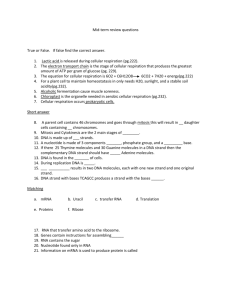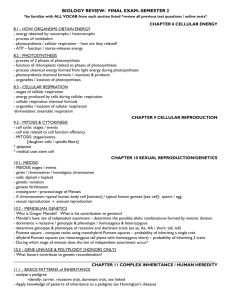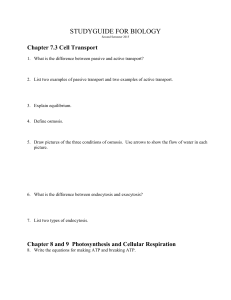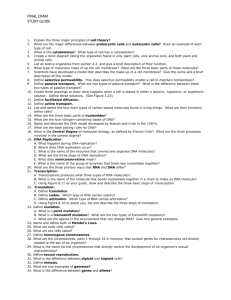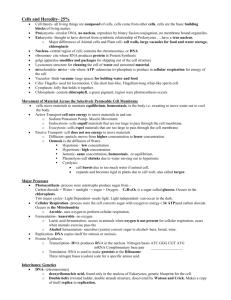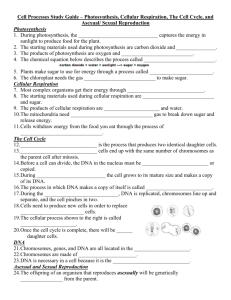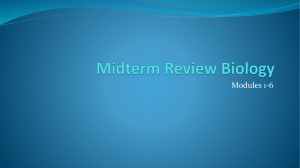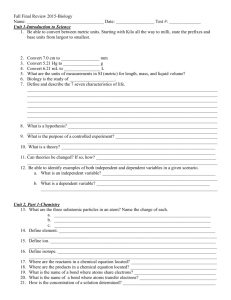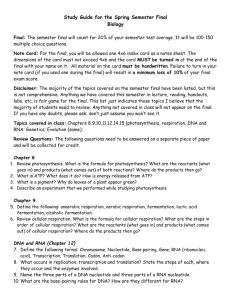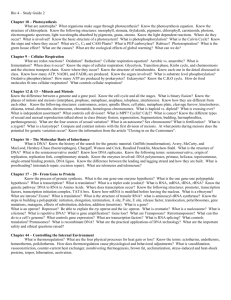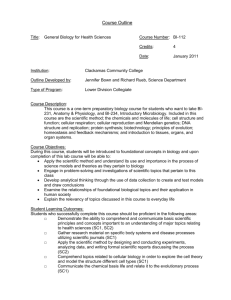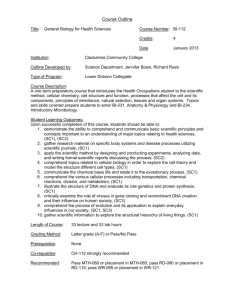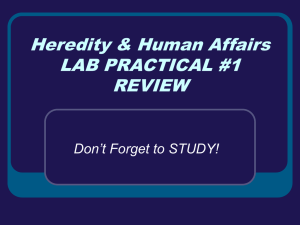BIOLOGY SEMESTER 1 FINAL REVIEW SHEET What is the
advertisement
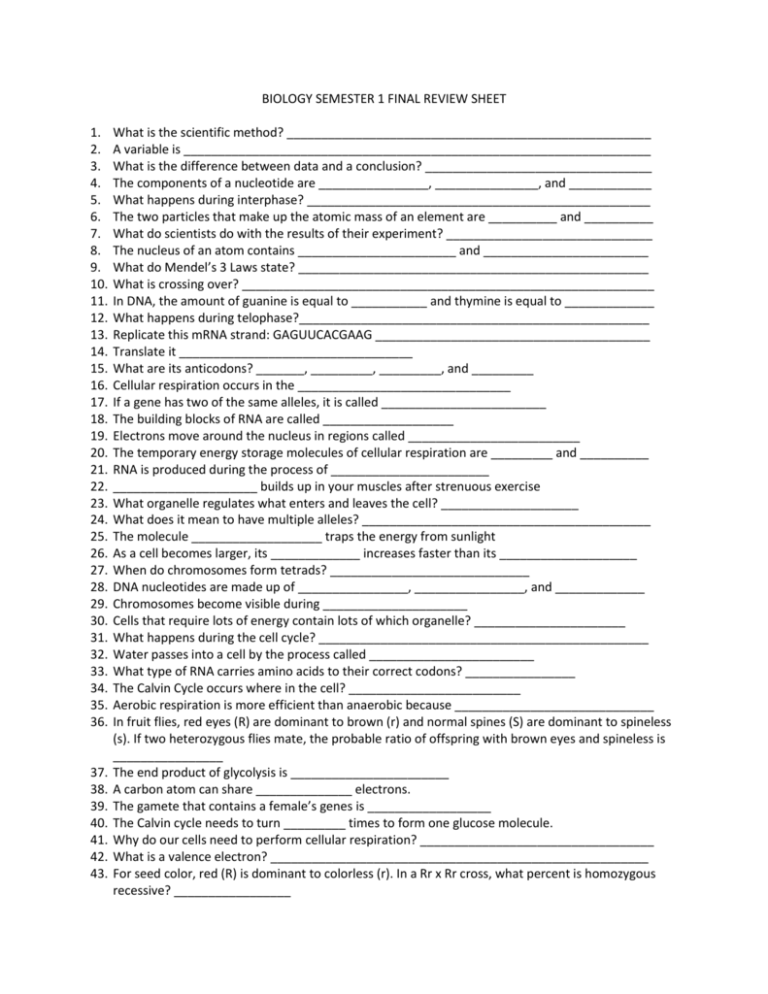
BIOLOGY SEMESTER 1 FINAL REVIEW SHEET 1. 2. 3. 4. 5. 6. 7. 8. 9. 10. 11. 12. 13. 14. 15. 16. 17. 18. 19. 20. 21. 22. 23. 24. 25. 26. 27. 28. 29. 30. 31. 32. 33. 34. 35. 36. 37. 38. 39. 40. 41. 42. 43. What is the scientific method? _____________________________________________________ A variable is ____________________________________________________________________ What is the difference between data and a conclusion? _________________________________ The components of a nucleotide are ________________, _______________, and ____________ What happens during interphase? __________________________________________________ The two particles that make up the atomic mass of an element are __________ and __________ What do scientists do with the results of their experiment? ______________________________ The nucleus of an atom contains _______________________ and ________________________ What do Mendel’s 3 Laws state? ___________________________________________________ What is crossing over? ____________________________________________________________ In DNA, the amount of guanine is equal to ___________ and thymine is equal to _____________ What happens during telophase?___________________________________________________ Replicate this mRNA strand: GAGUUCACGAAG ________________________________________ Translate it __________________________________ What are its anticodons? _______, _________, _________, and _________ Cellular respiration occurs in the _______________________________ If a gene has two of the same alleles, it is called ________________________ The building blocks of RNA are called ___________________ Electrons move around the nucleus in regions called _________________________ The temporary energy storage molecules of cellular respiration are _________ and __________ RNA is produced during the process of _______________________ _____________________ builds up in your muscles after strenuous exercise What organelle regulates what enters and leaves the cell? ____________________ What does it mean to have multiple alleles? __________________________________________ The molecule ___________________ traps the energy from sunlight As a cell becomes larger, its _____________ increases faster than its ____________________ When do chromosomes form tetrads? _____________________________ DNA nucleotides are made up of ________________, ________________, and _____________ Chromosomes become visible during _____________________ Cells that require lots of energy contain lots of which organelle? ______________________ What happens during the cell cycle? ________________________________________________ Water passes into a cell by the process called ________________________ What type of RNA carries amino acids to their correct codons? ________________ The Calvin Cycle occurs where in the cell? _________________________ Aerobic respiration is more efficient than anaerobic because _____________________________ In fruit flies, red eyes (R) are dominant to brown (r) and normal spines (S) are dominant to spineless (s). If two heterozygous flies mate, the probable ratio of offspring with brown eyes and spineless is ________________ The end product of glycolysis is _______________________ A carbon atom can share ______________ electrons. The gamete that contains a female’s genes is __________________ The Calvin cycle needs to turn _________ times to form one glucose molecule. Why do our cells need to perform cellular respiration? __________________________________ What is a valence electron? _______________________________________________________ For seed color, red (R) is dominant to colorless (r). In a Rr x Rr cross, what percent is homozygous recessive? _________________ 44. The cell membrane is made up of a(n) _______________ __________________ 45. The symbol that represents the number of chromosomes in a haploid cell is _____________ 46. In horses, a blaze (B) is dominant to no blaze (b) and coarse hair (C) is dominant to silky hair (c). What is the phenotype of a horse with the genotype BBcc? ______________________________ 47. DNA is replicated during the ________ phase of the cell cycle 48. Provide an example of a genotype for an organism the is heterozygous ____________________ 49. What organelle digests other worn-out organelles? ______________________ 50. DNA contains the nitrogen bases __________, ___________, ____________, and ___________ 51. BS, Bs, bS, and bs are the possible gamete combinations for the genotype ____________ 52. Watson and Crick suggested that the structure of DNA is _________________________ 53. What molecule is copied during replication? __________________ 54. During the ________ phase of mitosis, chromosomes form two groups near the poles of the spindle. 55. Animals store glucose in the form of ____________ and plants store it in the form of _________ 56. Name some examples of carbohydrates ______________________________________________ 57. The order of the phases of mitosis is 1. ________ 2. ________ 3. ________ 4. ___________ 58. The 4 components of the cell theory are 1. ____________________ 2. ____________________ 3. _______________________ 4. ____________________ 59. Releasing energy without the presence of oxygen is called ___________________ 60. Which organic molecule holds our genetic information? _____________________ 61. A testable prediction is a called a(n) ______________________ 62. Which forms of cell transport do not use energy? ___________, ___________, and __________ 63. The part of an experiment in which all conditions are kept the same is the __________________ 64. The equation for photosynthesis is _________ + __________ ____________ + ____________ 65. Chloroplasts are associated with what process? ____________________________ 66. How do we determine phenotype? _________________________________________________ 67. Cellular respiration yields _______ ATP 68. An example of codominance is ____________________ 69. What are purines and pyrimidines? _________________________________________________ 70. Ribosomes make ___________________ 71. Enzymes are an example of what organic molecule? ______________________ 72. What organelles do plant cells contain? ______________________________________________ 73. How does an autotroph obtain its food? _____________________________________________ 74. How is RNA different from DNA? ___________________________________________________ 75. In incomplete dominance inheritance, a cross between a red flower (RR) and white flower (rr) produces __________% pink flowers. 76. Organic compounds always contain __________________ 77. Amino acids are the subunits of _____________________ 78. An organelle is a structure in a(n) __________________ cell that performs a specific function. 79. The process of _______________ produces gametes. 80. If a parent with type B blood and a parent with type A blood have children that are ½ type AB and ½ type A, the parents’ genotypes are ___________ and _____________ 81. Meiosis results in genetically _______________ cells. 82. The 2 main stages of cell division are ______________ and ______________ 83. Describe the structure of a phospholipid _____________________________________________ 84. Enzymes act on molecules called _____________________ 85. Rows in the periodic table are called ______________ and columns are called _______________ 86. Yeast cells produce _______________ when they undergo fermentation.

